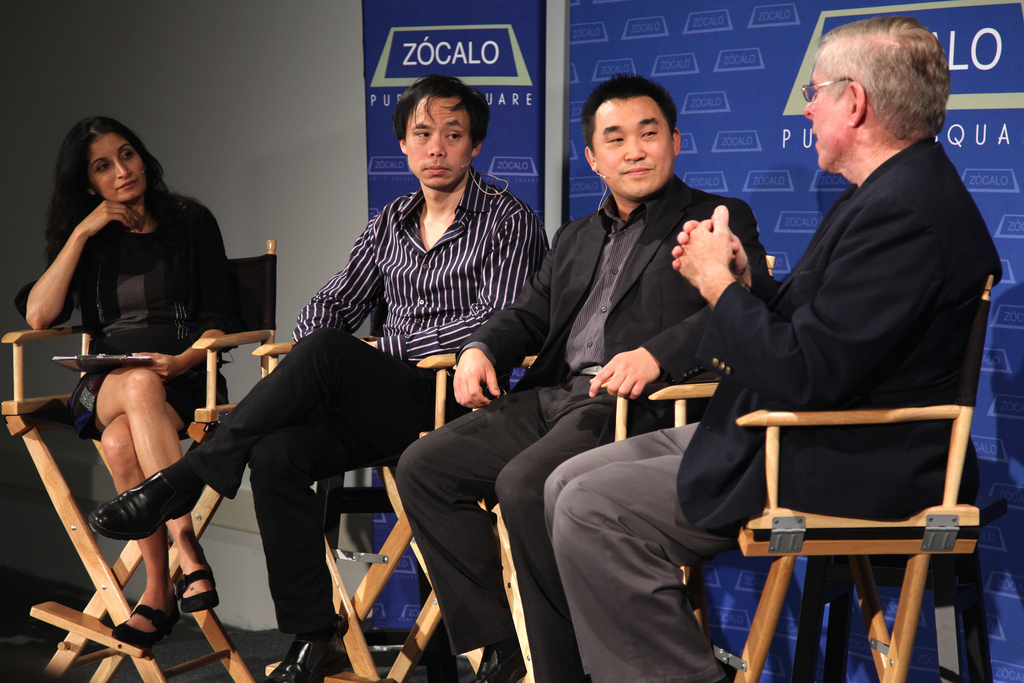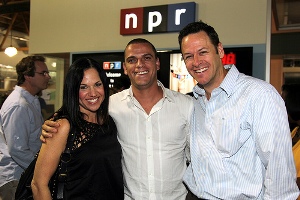
Before Dave deBronkart was known by his online moniker e-patient Dave, he was a typical offline patient with a troubling diagnosis: Stage IV kidney cancer with a very low survival rate.
But when deBronkart’s doctor referred him to an online community for kidney cancer patients, deBronkart found information so up-to-date that it beat medical journals, pointing him toward a rarely used treatment that restored his health.
“I’m a classic example of somebody who didn’t much care anything about healthcare or how the system works, until I had my ‘now I care’ moment,” he said.
In an event generously sponsored by the California HealthCare Foundation, deBronkart joined fellow panelists Thomas Lee, founder and CEO of One Medical Group, MedSimple founder Francis Kong, and moderator Indu Subaiya, co-founder of Health 2.0, to explore why online healthcare is crucial to better care and better communication.
Tech gets healthy, health gets techie
 The Internet brought to healthcare what it brought to every other field, as Lee explained: the digital distribution of information, a media format that each user can customize and make his own, and a means to share and contextualize information with other users. “Healthcare is an information intensive service industry,” Lee said. “You take those two together and you have an amazing subset of opportunities.”
The Internet brought to healthcare what it brought to every other field, as Lee explained: the digital distribution of information, a media format that each user can customize and make his own, and a means to share and contextualize information with other users. “Healthcare is an information intensive service industry,” Lee said. “You take those two together and you have an amazing subset of opportunities.”
That doesn’t mean those two elements play well together. As Lee explained, the business model for medicine doesn’t facilitate technology because of everything from the physical infrastructure to how insurance companies run. And as Kong noted, the extent to which healthcare can move online depends on how much patients are willing to use it. “It all comes down to how much you want to push yourself,” he says.
Kong also explained that healthcare and technology work in different ways. As a doctor, he said, “Even if you save a thousand lives, that one life lost is what you’ll be remembered for…. In technology, you can screw up a thousand times but that one success is what you’ll be remembered for.” Technology rewards risk, and medicine punishes it, and the two have to find a balance, he said.
Good information or garbage
On the patient side of things, deBronkart noted that a “filibuster proof majority” of adults routinely look online for healthcare information. Subaiya added that they form thousands of patient communities that go beyond message boards and blogs and random questions to sites that track the symptoms and medications of tens of thousands of patients – data that isn’t available in clinical trials. Patients also have access to medical records electronically – long illegal – and still developing and somewhat controversial hospital, doctor, and provider rankings websites. (The panelists noted that a peer-to-peer doctor review site would be helpful, since doctors can better evaluate performance of their colleagues than patients can.) Blue-tooth enabled monitoring devices can send email notices to doctors when a patient’s weight or blood pressure is too high or low.
All the panelists agreed that sorting out good information from garbage was the patient’s job. As deBronkart put it, “I met my wife online in 1999. I’ll tell you, I went through some garbage before I found her.”
Getting medical data right
 DeBronkart offered personal experience of where hospital-provided data can go wrong as well. When he put his medical data into one service, it suggested he shouldn’t be taking one of his prescribed medications, and gave him false medical warnings and conditions. “It was a whole bunch of things I used to have. They sent my entire history as if it were current,” he said. “We figured out what happened was they had sent not the clinical record, but the insurance billing code.” That stopped, he said, after his case won some media attention.
DeBronkart offered personal experience of where hospital-provided data can go wrong as well. When he put his medical data into one service, it suggested he shouldn’t be taking one of his prescribed medications, and gave him false medical warnings and conditions. “It was a whole bunch of things I used to have. They sent my entire history as if it were current,” he said. “We figured out what happened was they had sent not the clinical record, but the insurance billing code.” That stopped, he said, after his case won some media attention.
But he added, “I wonder if we can trust the information that’s in the hospital system. They don’t understand the data quality issues that are routine in the rest of IT.”
Lee agreed that healthcare data – paper and digital – is “kind of muddy.” His medical practice – which combines brick-and-mortar facilities with digital care – aims to correct data cleanly by figuring out what data matters, who should capture it, and how they should use it.
Vicious cycles and two-minute visits
Practices like Lee’s also allow for more communication between doctors and patients – and not just online. He noted that his doctors spend 30 to 45 minutes with patients, instead of the two to 10 minutes that Subaiya described as typical. Answering questions about symptoms online, before appointments, frees up doctors, and prevents the typical doctor’s office experience: “You feel like a product on an assembly line,” he said.
The question of doctors’ face-time with patients is a crucial and complicated one, as Kong explained. Unlike lawyers, doctors don’t charge by the minute. “When I was in medical school and I saw my teacher on the phone giving out free medical advice, I said, ‘Do we charge for that?’ and he says no,” Kong said. “It’s just not done.” Doctors have to see as many patients as possible to keep their practices running, Kong explained, characterizing it as a cycle. Doctors have to see more patients to charge for more procedures. This means they gather less data on patients, which can lead to medical errors, misdiagnosis, and lawsuits. Lawsuits in turn drive up premiums and increase operating costs, requiring doctors to see still more patients.
“Picture this cycle going on for 30 years, and you’ll have an idea of where we are today,” he said, adding, “I almost got fired from my residency because I spent too much time with patients.”
Kong suggested that doctors use web tools as lawyers would use paralegals: to collect and analyze all information and present it to the doctor. His company’s tools allow physicians to read a data sheet in 15 seconds instead of spending several minutes gathering information. Lee’s medical group even lets patients receive antibiotics without an office visit, using a questionnaire and a remote review by a clinical nursing team.
Business of medicine
 The panelists agreed that doctors don’t have the best business sense. Lee noted that everyone thought he was crazy when he went to get an MBA on top of his medical degree, but, he said, “It’s kind of like ‘The Matrix’. You see how everything works now…. You can design with the intent of a physician who wants to care for patients in a sane and rational way, but with the business principles.”
The panelists agreed that doctors don’t have the best business sense. Lee noted that everyone thought he was crazy when he went to get an MBA on top of his medical degree, but, he said, “It’s kind of like ‘The Matrix’. You see how everything works now…. You can design with the intent of a physician who wants to care for patients in a sane and rational way, but with the business principles.”
Kong recalled leaving medical school and seeing small businesses. “We see a grocery store. We think, oh, they did it. I can do it. And within a few years you’re already in the hole,” he said. “It’s probably the biggest business in the world, but most of the people who make the decisions have zero experience running a business. And the people in the middle – insurance companies, which are pure business – have no concern for health.” As Lee and Kong noted in Q&A, the insurance system in the U.S. is still flawed and has poor incentives, though Subaiya noted that some innovation is helping, creating online forums where doctors can bid on services and patients can negotiate hospital bills.
DeBronkart made the call for stopping lawsuits. “It’s an audacious thing we do when we cut somebody open and put chemicals in them with an attempt to fix their bodies,” he said. “I hate it when somebody’s career is ruined by a one in a million error.” He also reminded the audience of what online healthcare can’t replace, citing the case of one woman whose doctor caught her early tumors. “When she asked, ‘How did you know?’ He said, ‘You just didn’t seem like yourself,’” he said. “That’s the art of medicine.”
Watch the video here.
See more photos here.
Read an online roundtable about the future of online care here.
Read In The Green Room Q&As with Indu Subaiya, Thomas Lee, Francis Kong, and Dave deBronkart.
*Photos by Aaron Salcido.




Send A Letter To the Editors